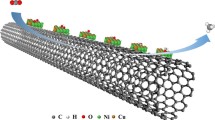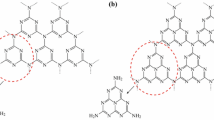Abstract
Core–shell super-structures were developed via π-stacking of poly[benzodithiophene-bis(decyltetradecyl-thien) naphthothiadiazole] (PBDT-DTNT) and poly[bis(triiso-propylsilylethynyl) benzodithiophene-bis(decyltetradecyl-thien) naphthobisthiadiazole] (PBDT-TIPS-DTNT-DT) as conductive shells onto carbon nanotubes (CNTs). Structure of conjugated polymers substantially determines their deposition model onto CNTs. Regioregular poly(3-hexyl thiophene) (P3HT) chains with hexyl side chains developed delicate nanofibrils with a base attached to CNT surface. However, PBDT-DTNT and PBDT-TIPS-DTNT-DT complicated conductive polymers with fused and infused thiophenic and benzenic rings preferred to be π-stacked with a face-on manner onto CNT surface and fabricate shells. Grafting of CNT surface with a polythiophene such as poly(3-dodecyl thiophene) (PDDT) introduced some defects onto the shell structure; because PBDT-DTNT and PBDT-TIPS-DTNT-DT polymers were not able to be π-deposited onto CNT surface grafted with PDDT. The PDDT grafts were considered as hindrances against the stacking of complicated polymers. The thickness of PBDT-DTNT and PBDT-TIPS-DTNT-DT shells ranged in 10–12 and 5–8 nm, respectively. Higher hindrance of TIPS side structures in PBDT-TIPS-DTNT-DT chains reflected thinner shells. By developing core–shells based on PBDT-TIPS-DTNT-DT and PBDT-DTNT, the conductivity reached 10.11 and 12.15 S/cm, respectively. Donor–acceptor core–shell nano-hybrids were then applied in active layer of photovoltaics. Efficiencies for CNT (core)-PBDT-DTNT (shell) and CNT (core)-PBDT-TIPS-DTNT-DT (shell) were 4.07 and 2.34%, respectively.







Similar content being viewed by others
Change history
10 October 2022
This article has been retracted. Please see the Retraction Notice for more detail: https://doi.org/10.1007/s10854-022-09186-6
References
K. Khan, A. Kausar, A.U. Rahman, Modern drifts in conjugated polymers and nanocomposites for organic solar cells: a review. Polym. Plast. Technol. Eng. 54(2), 140–154 (2015)
S. Bhadra, D. Khastgir, Degradation and stability of polyaniline on exposure to electron beam irradiation (structure–property relationship). Polym. Degrad. Stab. 92(10), 1824–1832 (2007)
G. Li, R. Zhu, Y. Yang, Polymer solar cells. Nat. Photonics 6(3), 153–161 (2012)
D. Dang, P. Zhou, L. Duan, X. Bao, R. Yang, W. Zhu, An efficient method to achieve a balanced open circuit voltage and short circuit current density in polymer solar cells. J. Mater. Chem. A 4(21), 8291–8297 (2016)
Y. Li, Molecular design of photovoltaic materials for polymer solar cells: toward suitable electronic energy levels and broad absorption. Acc. Chem. Res. 45(5), 723–733 (2012)
L. Huo, T. Liu, X. Sun, Y. Cai, A.J. Heeger, Y. Sun, Single-junction organic solar cells based on a novel wide-bandgap polymer with efficiency of 9.7%. Adv. Mater. 27(18), 2938–2944 (2015)
G. Yu, J. Gao, J.C. Hummelen, F. Wudl, A.J. Heeger, Polymer photovoltaic cells: enhanced efficiencies via a network of internal donor-acceptor heterojunctions. Science 270(5243), 1789–1791 (1995)
L. Ye, S. Zhang, W. Zhao, H. Yao, J. Hou, Highly efficient 2D-conjugated benzodithiophene-based photovoltaic polymer with linear alkylthio side chain. Chem. Mater. 26(12), 3603–3605 (2014)
N. Wang, W. Chen, W. Shen, L. Duan, M. Qiu, J. Wang, C. Yang, Z. Du, R. Yang, Novel donor–acceptor polymers containing o-fluoro-p-alkoxyphenyl-substituted benzo [1, 2-b: 4, 5-b′] dithiophene units for polymer solar cells with power conversion efficiency exceeding 9%. J. Mater. Chem. A 4(26), 10212–10222 (2016)
Y. Liu, J. Zhao, Z. Li, C. Mu, W. Ma, H. Hu, K. Jiang, H. Lin, H. Ade, H. Yan, Aggregation and morphology control enables multiple cases of high-efficiency polymer solar cells. Nat. Commun. 5, 5293 (2014)
Z. He, C. Zhong, S. Su, M. Xu, H. Wu, Y. Cao, Enhanced power-conversion efficiency in polymer solar cells using an inverted device structure. Nat. Photon. 6(9), 591–595 (2012)
M. Wang, X. Hu, P. Liu, W. Li, X. Gong, F. Huang, Y. Cao, Donor–acceptor conjugated polymer based on naphtho [1, 2-c: 5, 6-c] bis [1, 2, 5] thiadiazole for high-performance polymer solar cells. J. Am. Chem. Soc. 133(25), 9638–9641 (2011)
I. Osaka, T. Abe, M. Shimawaki, T. Koganezawa, K. Takimiya, Naphthodithiophene-based donor–acceptor polymers: versatile semiconductors for OFETs and OPVs. ACS Macro Lett. 1(4), 437–440 (2012)
I. Osaka, M. Shimawaki, H. Mori, I. Doi, E. Miyazaki, T. Koganezawa, K. Takimiya, Synthesis, characterization, and transistor and solar cell applications of a naphthobisthiadiazole-based semiconducting polymer. J. Am. Chem. Soc. 134(7), 3498–3507 (2012)
P. Guo, Y. Xia, F. Huang, G. Luo, J. Li, P. Zhang, Y. Zhu, C. Yang, H. Wu, Y. Cao, An alkylthieno-2-yl flanked dithieno [2, 3-d: 2′, 3′-d′] benzo [1, 2-b: 4, 5-b′] dithiophene-based low band gap conjugated polymer for high performance photovoltaic solar cells. RSC Adv. 5(17), 12879–12885 (2015)
E. Bundgaard, F.C. Krebs, Low-band-gap conjugated polymers based on thiophene, benzothiadiazole, and benzobis (thiadiazole). Macromolecules 39(8), 2823–2831 (2006)
T.T. Steckler, X. Zhang, J. Hwang, R. Honeyager, S. Ohira, X.H. Zhang, A. Grant, S. Ellinger, S.A. Odom, D. Sweat, D.B. Tanner, A spray-processable, low bandgap, and ambipolar donor–acceptor conjugated polymer. J. Am. Chem. Soc. 131(8), 2824–2826 (2009)
J. Tong, L. An, J. Li, P. Zhang, P. Guo, C. Yang, Q. Su, X. Wang, Y. Xia, Large branched alkylthienyl bridged naphtho [1,2-c:5,6-c′] bis [1,2,5] thiadiazole-containing low bandgap copolymers: Synthesis and photovoltaic application. J. Macromol. Sci. Part A 54(3), 176–185 (2017)
I. Osaka, T. Kakara, N. Takemura, T. Koganezawa, K. Takimiya, Naphthodithiophene–naphthobisthiadiazole copolymers for solar cells: alkylation drives the polymer backbone flat and promotes efficiency. J. Am. Chem. Soc. 135(24), 8834–8837 (2013)
X. Hu, M. Wang, F. Huang, X. Gong, Y. Cao, 23% Enhanced efficiency of polymer solar cells processed with 1-chloronaphthalene as the solvent additive. Synth. Met. 164, 1–5 (2013)
Y. Sun, J. Seifter, M. Wang, L.A. Perez, C. Luo, G.C. Bazan, F. Huang, Y. Cao, A.J. Heeger, Effect of molecular order on the performance of naphthobisthiadiazole-based polymer solar cells. Adv. Energy Mater. 4(6), 1–5 (2014)
C. Mu, P. Liu, W. Ma, K. Jiang, J. Zhao, K. Zhang, Z. Chen, Z. Wei, Y. Yi, J. Wang, S. Yang, High-efficiency all-polymer solar cells based on a pair of crystalline low-bandgap polymers. Adv. Mater. 26(42), 7224–7230 (2014)
V. Vohra, K. Kawashima, T. Kakara, T. Koganezawa, I. Osaka, K. Takimiya, H. Murata, Nat. Photon. 9, 403–409 (2015)
L. Huo, Y. Zhou, Y. Li, Alkylthio-substituted polythiophene: absorption and photovoltaic properties. Macromol. Rapid Commun. 30(11), 925–931 (2009)
C. Cui, W.Y. Wong, Y. Li, Improvement of open-circuit voltage and photovoltaic properties of 2D-conjugated polymers by alkylthio substitution. Energy Environ. Sci. 7(7), 2276–2284 (2014)
J.H. Kim, M. Lee, H. Yang, D.H. Hwang, A high molecular weight triisopropylsilylethynyl (TIPS)-benzodithiophene and diketopyrrolopyrrole-based copolymer for high performance organic photovoltaic cells. J. Mater. Chem. A 2(18), 6348–6352 (2014)
S. Wood, J.H. Kim, D.H. Hwang, J.S. Kim, Effects of fluorination and side chain branching on molecular conformation and photovoltaic performance of donor–acceptor copolymers. Chem. Mater. 27(12), 4196–4204 (2015)
H. Gu, T.M. Swager, Fabrication of free-standing, conductive, and transparent carbon nanotube films. Adv. Mater. 20(23), 4433–4437 (2008)
R. Allen, L. Pan, G.G. Fuller, Z. Bao, Using in-situ polymerization of conductive polymers to enhance the electrical properties of solution-processed carbon nanotube films and fibers. ACS Appl. Mater. Interfaces 6(13), 9966–9974 (2014)
X.I.A.O.L.E.I. Liu, J. Ly, S.O.N.G. Han, D.A.I.H.U.A. Zhang, A. Requicha, M.E. Thompson, C.H.O.N.G.W.U. Zhou, Synthesis and electronic properties of individual single-walled carbon nanotube/polypyrrole composite nanocables. Adv. Mater. 17(22), 2727–2732 (2005)
I.A. Tchmutin, A.T. Ponomarenko, E.P. Krinichnaya, G.I. Kozub, O.N. Efimov, Electrical properties of composites based on conjugated polymers and conductive fillers. Carbon 41(7), 1391–1395 (2003)
R.G. Goh, N. Motta, J.M. Bell, E.R. Waclawik, Effects of substrate curvature on the adsorption of poly (3-hexylthiophene) on single-walled carbon nanotubes. Appl. Phys. Lett. 88(5), 053101 (2006)
A. Star, J.F. Stoddart, D. Steuerman, M. Diehl, A. Boukai, E.W. Wong, X. Yang, S.W. Chung, H. Choi, J.R. Heath, Preparation and properties of polymer-wrapped single-walled carbon nanotubes. Angew. Chem. Int. Ed. 40(9), 1721–1725 (2001)
J. Chen, H. Liu, W.A. Weimer, M.D. Halls, D.H. Waldeck, G.C. Walker, Noncovalent engineering of carbon nanotube surfaces by rigid, functional conjugated polymers. J. Am. Chem. Soc. 124(31), 9034–9035 (2002)
Author information
Authors and Affiliations
Corresponding author
Additional information
This article has been retracted. Please see the retraction notice for more detail:https://doi.org/10.1007/s10854-022-09186-6
Electronic supplementary material
Below is the link to the electronic supplementary material.
Rights and permissions
Springer Nature or its licensor (e.g. a society or other partner) holds exclusive rights to this article under a publishing agreement with the author(s) or other rightsholder(s); author self-archiving of the accepted manuscript version of this article is solely governed by the terms of such publishing agreement and applicable law.
About this article
Cite this article
Agbolaghi, S. RETRACTED ARTICLE: Core–shell super-structures via smart deposition of naphthothiadiazole and benzodithiophene-possessing polymer backbones onto carbon nanotubes and photovoltaic applications thereof. J Mater Sci: Mater Electron 30, 832–841 (2019). https://doi.org/10.1007/s10854-018-0353-x
Received:
Accepted:
Published:
Issue Date:
DOI: https://doi.org/10.1007/s10854-018-0353-x




